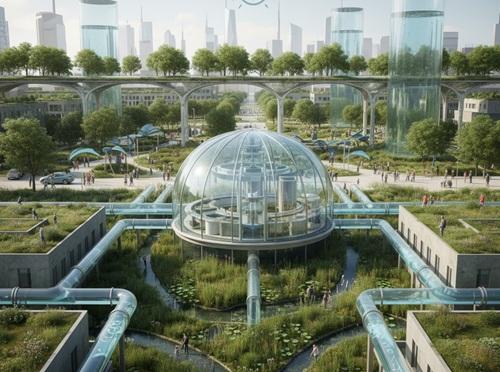Water Reuse Market Hits New High | Major Giants Veolia, Xylem, SUEZ – openPR.com

Global Water Reuse Market Analysis: A Report on Sustainable Water Management
Executive Summary and Alignment with Sustainable Development Goals (SDGs)
This report provides a comprehensive analysis of the Global Water Reuse Market for the period 2025-2033. The practice of water reuse, which involves treating wastewater for subsequent use, is a critical component in achieving global sustainability targets. It directly supports the United Nations Sustainable Development Goals, particularly SDG 6 (Clean Water and Sanitation), by conserving finite freshwater resources and promoting sustainable water management. Furthermore, the expansion of this market is integral to developing resilient infrastructure for SDG 11 (Sustainable Cities and Communities) and fostering circular economies as outlined in SDG 12 (Responsible Consumption and Production).
Market Projections (2025-2033)
The Global Water Reuse Market is projected to experience significant growth, expanding from an estimated value of $9.8 Billion in 2025 to $21.4 Billion by 2033. This represents a Compound Annual Growth Rate (CAGR) of 9.90% over the forecast period, underscoring the increasing global commitment to water security and sustainability.
Key Industry Participants
The market is characterized by the presence of several major technology and service providers, including:
- Veolia
- Xylem
- SUEZ
- A. O. Smith
- Pentair
- IDE Technologies
- Aqualia
- United Utilities
- AquaTech
- Flowserve
Market Segmentation Analysis
Segmentation by Technology Type
The market is segmented based on the primary technologies employed for water reclamation:
- Reclaimed water systems
- Greywater systems
- Desalination reuse systems
Segmentation by Application
Water reuse technologies are applied across various sectors, each contributing to specific sustainability objectives:
- Municipal water systems: Enhances urban water security, supporting SDG 11.
- Industrial wastewater treatment: Promotes responsible industrial water use, aligning with SDG 9 and SDG 12.
- Agricultural irrigation: Addresses water scarcity in food production, contributing to SDG 2 and SDG 6.
- Landscaping: Reduces the use of potable water for non-potable purposes.
- Potable water systems: Represents an advanced application to directly augment drinking water supplies, crucial for water-stressed regions under SDG 6.
Regional Market Outlook
Dominant and High-Growth Regions
- Dominating Region: North America – Established regulatory frameworks and significant investment in water infrastructure drive market leadership.
- Fastest-Growing Region: Asia-Pacific – Rapid urbanization, industrial growth, and increasing water stress are accelerating the adoption of water reuse technologies, making it a critical area for achieving SDG 6 and SDG 11.
Market Dynamics and SDG Implications
Market Drivers
The primary forces propelling market growth are intrinsically linked to global sustainability challenges:
- Growing Freshwater Scarcity: The most significant driver, directly pushing for solutions to meet the targets of SDG 6.
- Industrial Sector Mandates: Environmental regulations requiring wastewater recycling support the principles of SDG 12.
- Government Incentives: Policies promoting decentralized treatment and reuse projects facilitate the development of sustainable infrastructure for SDG 11.
- Rising Urbanization: Increased demand for sustainable water infrastructure in cities is a core theme of SDG 11.
Market Trends
Current trends reflect technological advancements and policy shifts toward a more sustainable water future:
- Circular Water Economies: A global policy shift that aligns with the core principles of SDG 12.
- Smart Monitoring: The use of IoT ensures water quality compliance, enhancing accountability for SDG 6 targets.
- Integration with Renewable Energy: Off-grid water reuse facilities support both SDG 7 (Affordable and Clean Energy) and SDG 13 (Climate Action).
- Advanced Treatment Systems: The adoption of hybrid membrane and UV disinfection systems improves the safety and viability of water reuse.
- Modular Systems: Containerized systems are gaining popularity for flexible deployment in developing urban areas.
Market Challenges
Several obstacles hinder the widespread adoption of water reuse, posing risks to the achievement of related SDGs:
- Public Acceptance: Mistrust of recycled water remains a significant social barrier to implementing SDG 6 solutions.
- High Costs: The capital and maintenance costs of advanced filtration systems can be prohibitive, particularly for developing economies.
- Policy Inconsistencies: A lack of harmonized regulations delays implementation and investment.
- Environmental Concerns: The disposal of treatment by-products like brine and sludge presents environmental challenges that must be managed sustainably.
Market Opportunities
The market presents numerous opportunities to advance sustainable development:
- Industrial Expansion: New industrial zones create high-value opportunities for closed-loop water systems, advancing SDG 9 and SDG 12.
- Sustainable Urban Development: Integration of dual plumbing for greywater recycling in new housing projects is a direct contribution to SDG 11.
- Agricultural Sustainability: Using treated water for irrigation supports food security (SDG 2) while conserving freshwater (SDG 6).
- Emerging Economies: Public-Private Partnership (PPP) models can unlock significant growth potential and help these nations meet their SDG 6 targets.
Analysis of Sustainable Development Goals in the Article
1. Which SDGs are addressed or connected to the issues highlighted in the article?
-
SDG 6: Clean Water and Sanitation
- The entire article is centered on water reuse, which is a core component of sustainable water management. It directly addresses issues of water scarcity, wastewater treatment, and providing safe water for various uses, as stated in the definition: “The primary goal of water reuse is to conserve water resources, reduce demand on natural water supplies, and promote sustainable water management practices.”
-
SDG 9: Industry, Innovation, and Infrastructure
- The article discusses the development and adoption of “sustainable water infrastructure” and advanced technologies. It highlights market trends like “hybrid membrane and UV disinfection systems,” “Smart monitoring using IoT,” and “modular containerized systems,” which are all examples of innovation in infrastructure to achieve sustainability.
-
SDG 11: Sustainable Cities and Communities
- The text links water reuse directly to urban development. It notes that “Rising urbanization increases demand for sustainable water infrastructure” and identifies opportunities in “Urban housing projects [that] integrate dual plumbing for greywater recycling” and the use of “modular containerized systems… in developing cities.”
-
SDG 12: Responsible Consumption and Production
- The concept of a “circular water economy,” mentioned as a market trend, is central to SDG 12. The article emphasizes how “Industrial sectors prioritize wastewater recycling to meet environmental mandates,” which promotes the sustainable management and efficient use of natural resources (water).
-
SDG 2: Zero Hunger
- The article explicitly connects water reuse to sustainable agriculture by listing “Agricultural irrigation” as a key application and an opportunity where “Agricultural irrigation from treated water supports sustainability goals.” This practice helps ensure sustainable food production systems, especially in water-scarce regions.
2. What specific targets under those SDGs can be identified based on the article’s content?
-
Target 6.3: By 2030, improve water quality by reducing pollution, eliminating dumping and minimizing release of hazardous chemicals and materials, halving the proportion of untreated wastewater and substantially increasing recycling and safe reuse globally.
- The article’s focus on “treating wastewater to remove contaminants” and its application in “municipal water systems, industrial wastewater treatment, [and] agricultural irrigation” directly supports this target of increasing recycling and safe reuse.
-
Target 6.4: By 2030, substantially increase water-use efficiency across all sectors and ensure sustainable withdrawals and supply of freshwater to address water scarcity.
- The article states that a key market driver is “Growing freshwater scarcity” and that the goal of water reuse is to “conserve water resources” and “reduce demand on natural water supplies,” which aligns perfectly with increasing water-use efficiency.
-
Target 9.4: By 2030, upgrade infrastructure and retrofit industries to make them sustainable, with increased resource-use efficiency and greater adoption of clean and environmentally sound technologies and industrial processes.
- This is addressed through the market trends mentioned, such as the adoption of “hybrid membrane and UV disinfection systems,” “smart monitoring using IoT,” and the “integration with renewable energy,” which are all clean and efficient technologies for water infrastructure.
-
Target 11.1: By 2030, ensure access for all to adequate, safe and affordable housing and basic services and upgrade slums.
- The article connects water reuse to providing basic services in urban areas, noting that “rising urbanization increases demand for sustainable water infrastructure” and that “urban housing projects integrate dual plumbing for greywater recycling.”
-
Target 12.2: By 2030, achieve the sustainable management and efficient use of natural resources.
- The trend of “Global policy frameworks… shifting toward circular water economies” and the practice of “industrial wastewater treatment” are direct efforts towards the sustainable management and efficient use of water as a natural resource.
-
Target 2.4: By 2030, ensure sustainable food production systems and implement resilient agricultural practices that increase productivity and production.
- The opportunity for “Agricultural irrigation from treated water” is a clear example of a resilient agricultural practice that supports sustainable food production, particularly in the face of water scarcity.
3. Are there any indicators mentioned or implied in the article that can be used to measure progress towards the identified targets?
-
Proportion of wastewater safely treated and reused (Implied for Target 6.3)
- The entire article is about the market for water reuse technologies and systems. The projected market growth from “$9.8 Billion in 2025 to 21.4 Billion by 2033” serves as a strong financial proxy indicator for the increasing volume and proportion of wastewater being treated and reused globally.
-
Increase in water-use efficiency (Implied for Target 6.4)
- The article’s premise is that water reuse is driven by “growing freshwater scarcity” and aims to “reduce demand on natural water supplies.” The rate of adoption of water reuse systems in municipal, industrial, and agricultural sectors is an indirect measure of efforts to improve water-use efficiency.
-
Adoption of clean and environmentally sound technologies (Mentioned for Target 9.4)
- The article explicitly mentions several technological trends that can be measured as indicators, including the market penetration of “hybrid membrane and UV disinfection systems,” the number of facilities using “Smart monitoring using IoT,” and the number of “off-grid water reuse facilities” integrated with “renewable energy.”
-
Implementation of policies for sustainable resource management (Mentioned for Target 12.2)
- The article points to a qualitative indicator: “Global policy frameworks are shifting toward circular water economies.” The number of countries or regions adopting such policy frameworks can be tracked to measure progress.
4. Summary Table of SDGs, Targets, and Indicators
| SDGs | Targets | Indicators Identified in the Article |
|---|---|---|
| SDG 6: Clean Water and Sanitation | 6.3: Substantially increase recycling and safe reuse of water. 6.4: Substantially increase water-use efficiency. |
– Market size and growth of the water reuse industry (e.g., from $9.8B to $21.4B) as a proxy for the volume of treated wastewater. – Rate of adoption of reuse systems to reduce demand on freshwater supplies. |
| SDG 9: Industry, Innovation, and Infrastructure | 9.4: Upgrade infrastructure and industries with clean and environmentally sound technologies. | – Adoption rate of specific technologies mentioned: “hybrid membrane and UV disinfection systems,” “Smart monitoring using IoT,” and “modular containerized systems.” – Number of facilities integrating water reuse with renewable energy. |
| SDG 11: Sustainable Cities and Communities | 11.1: Ensure access to basic services (like water) in urban areas. | – Number of “urban housing projects” integrating “dual plumbing for greywater recycling.” – Deployment of “modular containerized systems” in “developing cities.” |
| SDG 12: Responsible Consumption and Production | 12.2: Achieve the sustainable management and efficient use of natural resources. | – Number of national/regional “policy frameworks… shifting toward circular water economies.” – Level of investment by “industrial sectors” in “wastewater recycling.” |
| SDG 2: Zero Hunger | 2.4: Ensure sustainable food production systems and resilient agricultural practices. | – The extent of “agricultural irrigation from treated water” as an implemented practice. |
Source: openpr.com
What is Your Reaction?
 Like
0
Like
0
 Dislike
0
Dislike
0
 Love
0
Love
0
 Funny
0
Funny
0
 Angry
0
Angry
0
 Sad
0
Sad
0
 Wow
0
Wow
0



















































.jpg.webp?itok=0ZsAnae9#)















.jpg?#)










